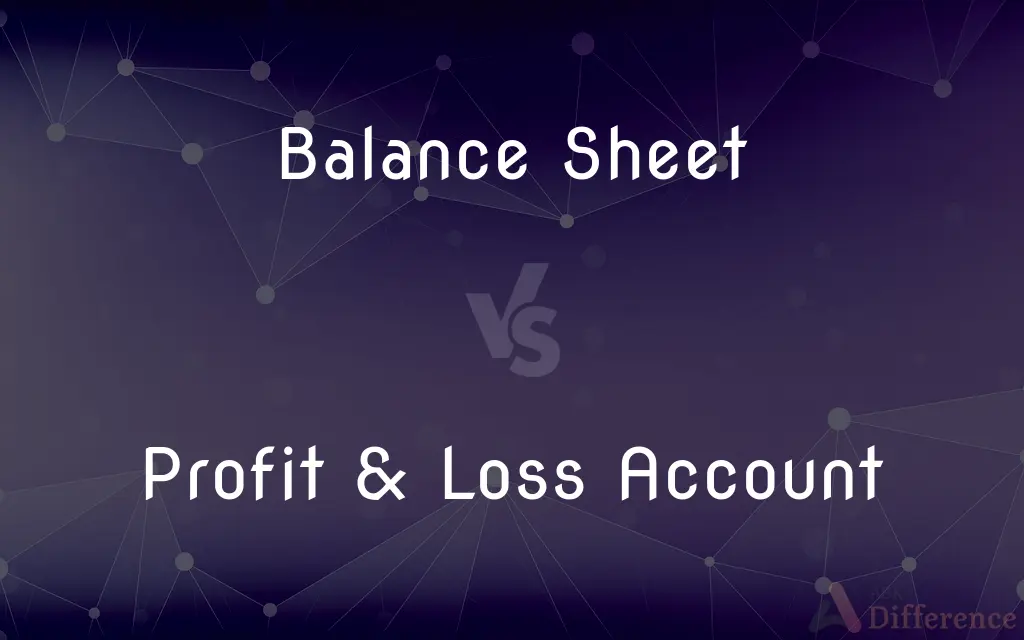Balance Sheet vs. Profit & Loss Account — What's the Difference?
By Tayyaba Rehman — Published on December 12, 2023
A Balance Sheet represents a company's assets, liabilities, and equity at a specific point in time; a Profit & Loss Account shows a company's revenues and expenses over a period, reflecting its profitability.

Difference Between Balance Sheet and Profit & Loss Account
Table of Contents
ADVERTISEMENT
Key Differences
The Balance Sheet and Profit & Loss Account are both fundamental financial statements, but they serve different purposes in the realm of financial accounting. While the Balance Sheet captures the financial position of a company at a single point in time, the Profit & Loss Account documents the financial performance over a specific period.
A Balance Sheet is an organized representation of a company's financial position, detailing its assets, liabilities, and shareholders' equity. It abides by the equation: Assets = Liabilities + Equity. This equation ensures that the company's resources are balanced against its financial obligations and the equity stake held by its owners. In contrast, a Profit & Loss Account, often called an income statement, lays out the revenues earned and expenses incurred, ultimately showing the net profit or loss for a particular period.
Balance Sheet items, like assets and liabilities, can be either short-term (current) or long-term. These classifications help in assessing the liquidity and solvency of a company. On the other hand, a Profit & Loss Account itemizes revenues and expenses, highlighting operating and non-operating activities. This distinction helps in understanding the core operations versus other financial events.
Interpreting a Balance Sheet involves analyzing the composition and quality of assets, the structure of liabilities, and the equity's size. A sound Balance Sheet typically indicates a financially healthy company. Conversely, analyzing a Profit & Loss Account revolves around understanding revenue streams, cost structures, and the resulting profitability. A profitable Profit & Loss Account can signal a company's operational strength.
While the Balance Sheet's main components remain consistent over time, the items on a Profit & Loss Account can vary based on the company's operations, industry standards, and accounting policies. Revenue recognition, expense categorization, and presentation can differ across Profit & Loss Accounts, whereas the basic structure of a Balance Sheet remains relatively constant.
ADVERTISEMENT
Comparison Chart
Nature
Snapshot at a specific date
Performance over a time period
Main Components
Assets, Liabilities, Equity
Revenues, Expenses, Profit/Loss
Purpose
Show financial position
Display financial performance
Time Frame
Single point in time
Specific duration (e.g., a month, quarter, year)
Analysis Focus
Liquidity, solvency, financial structure
Profitability, revenue streams, cost structure
Compare with Definitions
Balance Sheet
A representation of a company's resources and obligations alongside owner's interest.
The Balance Sheet highlighted a surge in long-term liabilities.
Profit & Loss Account
An account detailing a company's financial performance during a specified duration.
This year's Profit & Loss Account revealed higher operational costs.
Balance Sheet
An organized layout of a firm's financial standings on a particular date.
The quarterly Balance Sheet revealed a steady increase in retained earnings.
Profit & Loss Account
A statement reflecting a firm's earnings and expenditures, leading to net profit or loss.
After assessing the Profit & Loss Account, management decided to cut certain discretionary expenses.
Balance Sheet
A financial statement displaying a company's assets, liabilities, and equity at a specific date.
At year-end, the Balance Sheet showed a significant increase in assets due to a large acquisition.
Profit & Loss Account
A document capturing the monetary results of a company's business activities.
The monthly Profit & Loss Account showed a dip in sales revenues.
Balance Sheet
A snapshot of a company's financial position at a given moment.
The Balance Sheet on December 31st provided insights into the company's cash reserves.
Profit & Loss Account
An overview of how a company's operations have translated into financial outcomes.
The annual Profit & Loss Account highlighted the success of the new product line.
Balance Sheet
A statement detailing what a company owns and owes, along with shareholder equity.
Reviewing the Balance Sheet, investors gauged the company's debt levels.
Profit & Loss Account
A financial statement summarizing revenues, expenses, and profitability over a period.
The Profit & Loss Account for 2022 showed a net profit margin of 15%.
Common Curiosities
What's the primary purpose of a Balance Sheet?
To show a company's financial position at a specific point in time.
How does a Profit & Loss Account differ in its time frame from a Balance Sheet?
A Profit & Loss Account represents financial performance over a period, while a Balance Sheet is a snapshot at a specific date.
Which statement would best indicate a company's profitability?
The Profit & Loss Account.
Can a company have a strong Balance Sheet but a weak Profit & Loss Account?
Yes, a company might have healthy assets and equity but still experience operational losses.
Where can you find the cost of goods sold for a company?
In the Profit & Loss Account.
Are shareholder investments listed on the Balance Sheet?
Yes, under the equity section.
Is depreciation listed on the Balance Sheet?
Indirectly, as assets are shown at their depreciated values.
Which statement can help assess a company's debt levels?
The Balance Sheet.
How are sales revenues represented in financial statements?
In the Profit & Loss Account.
Can a firm's liquidity be gauged using the Profit & Loss Account?
No, liquidity is best assessed using the Balance Sheet.
Can one ascertain a company's sales growth using the Balance Sheet?
No, sales growth is derived from the Profit & Loss Account.
Where do we see a company's tax expenses?
In the Profit & Loss Account.
How are dividends reflected in these statements?
Dividends paid reduce retained earnings on the Balance Sheet and are also reflected in the Profit & Loss Account as an expense or distribution.
What does a negative equity value indicate on a Balance Sheet?
It suggests liabilities exceed assets, indicating potential financial distress.
Which statement would an investor review for dividend income from investments?
The Profit & Loss Account.
Share Your Discovery

Previous Comparison
Apps vs. Widgets
Next Comparison
Baryons vs. MesonsAuthor Spotlight
Written by
Tayyaba RehmanTayyaba Rehman is a distinguished writer, currently serving as a primary contributor to askdifference.com. As a researcher in semantics and etymology, Tayyaba's passion for the complexity of languages and their distinctions has found a perfect home on the platform. Tayyaba delves into the intricacies of language, distinguishing between commonly confused words and phrases, thereby providing clarity for readers worldwide.
















































